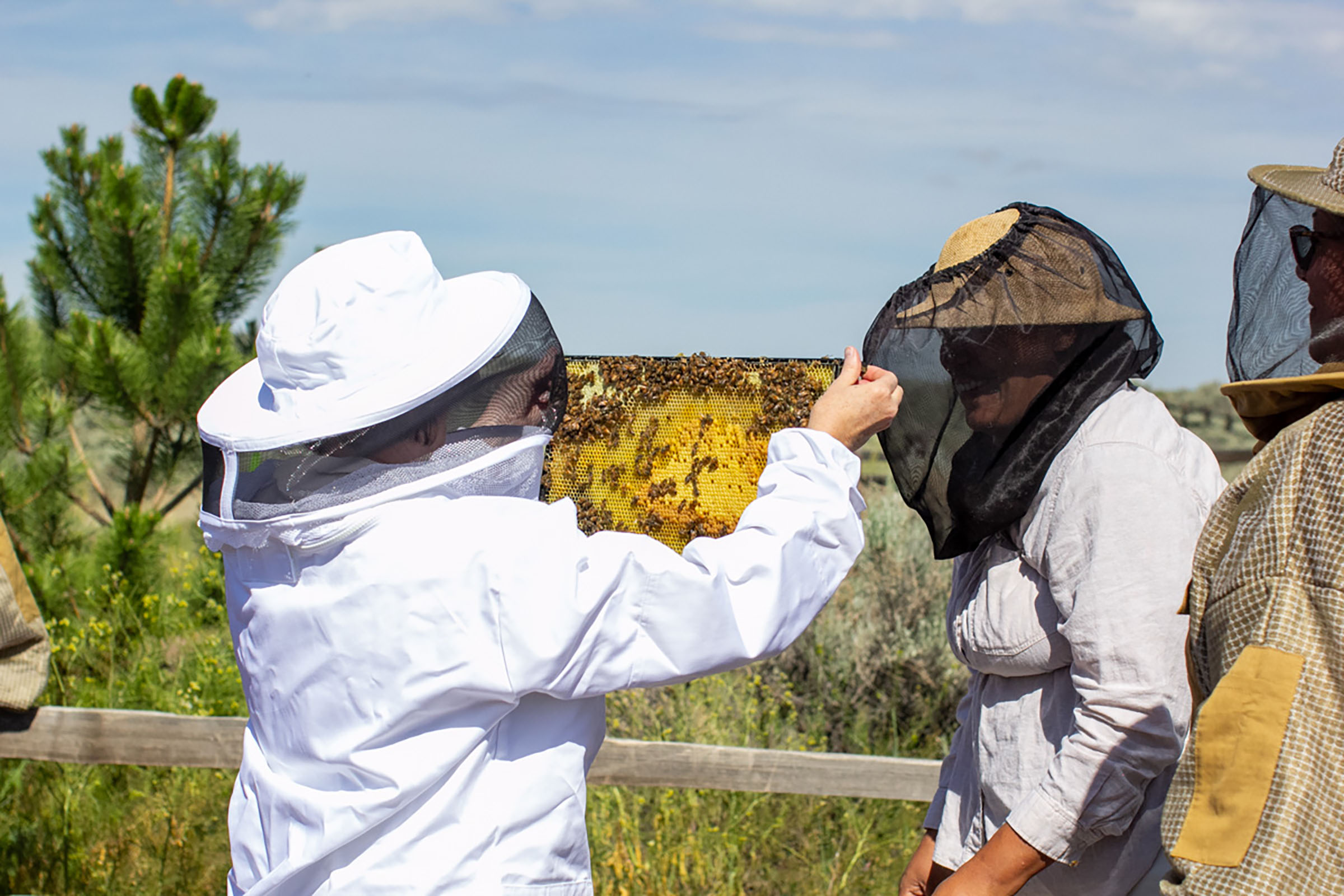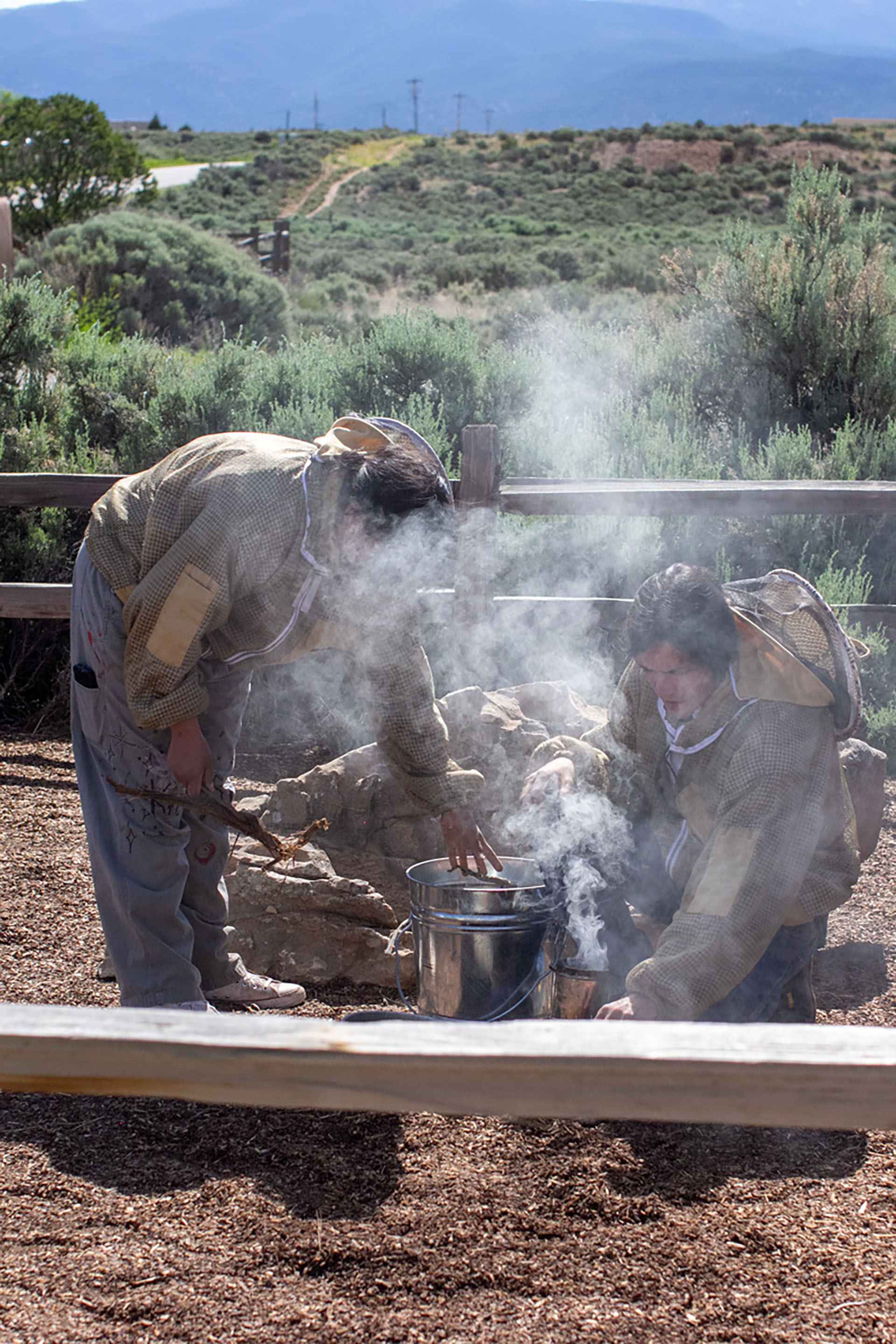UNM-Taos Introduces Campus Apiary
June 7, 2023

Photos by Enrico Trujillo
L-R, UNM-Taos lead beekeeper Cathy Brandenburg looks for the queen bee and inspects a comb before placing it in a hive as Melanie Kirby of Zia Queenbee Company and IAIA, and an IAIA student look on.
Honey bees, the tiny drifters in steady search of blooms from which they fill their pollen baskets, have a designated home on UNM-Taos Klauer campus.
By late May, two Langstroth traditional beehives were in place on a plot by the sculptures at the main campus entrance. To protect the hives, three pine trees — so far — were planted nearby to serve as a windbreak. Supplies such as books, gloves, jackets, veils, basic hive tools and a smoker were delivered. Landscapers finished mulching and doing some nearby trail repair. A drip irrigation system was installed to feed the pollinating plants. On the morning of June 6, the honey bees (also spelled honeybees) arrived from Zia Queenbee Company.
In the spring of 2021, Melanie Kirby (Tortugas Pueblo), founder of Zia Queenbee Company and Institute of American Indian Arts (IAIA) Land-Grant Extension educator, established honey bee hives on the IAIA campus in Santa Fe and hired several student workers to help grow the community of pollinators.
“The bees are mostly of the Caucasian variety, but are of mixed genes selected for longevity,” Kirby said. “They are the product of a melting pot, like America.”
Caucasian bees are hearty. They originate from the high valleys of the Central Caucasus Mountains in the country of Georgia and are a subspecies of the western honey bee (aka European honey bee).
The mixed strain of honey bees bred by Zia Queenbee was raised in Vadito, New Mexico. They were then packaged and transported in a nucleus (or “nuc,” pronounced “nuke”) hive, which is a miniature hive created for easy placement into a hive box. The nuc has everything needed for the queen and the bees to grow into a productive colony. Starting with this type of hive means simple installation and quicker population growth.
A common nuc hive setup includes four to five frames: a mated queen who has already filled one to two frames with brood, and thousands of bees working alongside the queen. They were given time to store enough food reserves to sustain them during transportation. The bee eggs will hatch in the weeks following being put in the new hive.
To make sure they have enough pollen to collect, 10 different varieties of bee-attracting plants donated by High Country Gardens are taking root near the hives. The pollinator garden is made up of high-level pollen, honey-bearing plants. High Country Gardens makes annual plant donations to support its mission of sustainable gardening across the West. The donated plants that will be placed near the apiary are Red Velvet Yarrow, Mellow Yellows Echinacea, Sharon Roberts English Lavender, Palmer’s Penstemon, Royal Candles Veronica, Blue Nepeta, Prince’s Plume, Blue Hyssop, Compass Plant and Star Frost Globe Thistle. These plants are bee cultivators, rabbit resistant, and are good for our growing zone.
High Country Gardens is part of a larger corporation called American Meadows, a group that’s done a lot of work with pre-K–12 student pollinator programs throughout the country.
“We’re happy to donate plants for this project and have been involved in many similar projects. We’re excited to support pollinators,” said Tabar L. Gifford, High Country Gardens customer experience and partnership cultivator. “The questions we ask ensure we’re helping [UNM-Taos] get the right plants at the right time.”
Many people tend to see dandelions as invasive weeds that need to be dug up or shot with herbicides. But because dandelions are the first spring plants to supply pollen for bees, UNM-Taos will no longer be removing all of them.
Apiary project origins
Two years ago, Paul Carattini, former manager of Facilities Operations at UNM-Taos, noticed a lot of bees whizzing around Klauer campus enjoying the Russian sage and apple tree.
“I’ve wanted to be a beekeeper my whole life, ever since childhood,” Carattini said, “but my brother was allergic.”
Because he got his chance to learn the art of beekeeping about five years ago and has since nurtured healthy hives, Carattini asked UNM-Taos Chancellor Mary Gutierrez if he could put out some swarm traps from which he would create another hive for himself. That request gave Chancellor Gutierrez an idea: How about creating an apiary on campus instead?
“Bees are under threat, so an apiary will help them,” she said. “Because we’re a learning campus, this is also an opportunity to educate the community and develop a science curriculum around it.”
Bees and other pollinators — such as butterflies, bats, birds, moths, flies, wasps, beetles and small mammals — are increasingly under threat from human activities. Academic research has documented the loss of biodiversity, the decline in bee populations and the critical importance of conservation efforts. However, knowledge about conservation requirements is not widespread. Additionally, attitudes, perceptions and emotions toward bees vary and impact people’s support and selection of pollinator conservation options.
Last summer, UNM-Taos Senior Institutional Researcher Alejandra Villalobos Melendez sent out a campuswide survey about having beehives on campus. The results showed sweeping support (92%) for an apiary.
“Bees on campus is kind of a movement,” she said. “There are college campuses across the country doing some cool stuff.”
Others jumping in from the start to help get the apiary project off the ground were UNM-Taos staffers Cathy Brandenburg, Cami Hartman, Stephanie Madrid, Kayla Platoff and Suzanne Hassell.
Educational opportunities
To further progress a showcase of pollinator space and conservation, UNM-Taos is exploring the opportunity of a potential partnership with IAIA. An idea being discussed is to use the beehives for a variety of educational purposes such as introduction to entomology, conservation and habitat restoration, the importance of pollinators for agriculture, biology and other topics. There is a seating area near the hives to accommodate demonstrations.
Kirby said demonstrations and other educational events will be finalized later because “We’re still figuring out potential workshop ideas.”
Over time, UNM-Taos sees potential for many other areas of development that could include:
- IAIA-hosted virtual workshops for UNM-Taos students and community members.
- serving as a resource for apiculture (beekeeping) learning in Northern New Mexico.
- development of marked pollinator-friendly gardens.
- hosting K-12 students for learning and exploration.
- provide opportunities for student service-learning projects.
- hosting Taos Pueblo beekeepers who are students at the IAIA.
- developing group workshops around beehive keeping and conservation.
- honey harvesting options depending on availability.
The caring of the bees
Carattini recently retired and won’t be holding the beekeeping reins but, he’s found someone who will: Administration Assistant to the Dean Catherine “Cathy” Brandenburg.
“I got involved because Paul asked if I was interested in doing it because I’ve talked to him about bees before,” Brandenburg recalled. “And I was willing to help him when he was going to be the beekeeper. I've always wanted to learn how to do it.”
Brandenburg readily admits she doesn’t know everything about being a beekeeper — yet. “Thus, I’m reading a lot of books,” she said. “I really didn't know much about bees, but I've learned all sorts of really cool things already.”
One of those cool things she learned is that you can tell what kinds of eggs were laid in the honeycombs depending on whether their tops are flat or round, allowing them to be identified as drones or queens. She also didn’t know that skunks eat bees. Skunks will scratch the bottom of a hive, she said, to annoy the bees who then fly out to see what the threat is making them easy pickings.
Brandenburg isn’t worried about bears but said the skunks are a potential problem she’ll need to address, as is creating shade around the hives to protect the bees from summer’s heat. Another concern she has is the thought that someone might have a bee allergy and not know it. She is investigating getting at least a couple of EpiPens to place in a box near the hives, just in case.
One more interesting thing she’s learned is that a lot of beekeepers don't wear gloves on their hands. “If you smoosh a bee by accident, it releases a pheromone that gets the other bees excited and ready to sting you,” she explained. “That pheromone, interestingly enough, smells like bananas.”
Brandenburg anticipates the most care for the bees will come when first placed in their new home by keeping them supplied with a food supplement of sugar water, regularly checking the hive for disease and making sure the queen is doing well.
“Harvesting honey is probably not going to be an issue, because I don't think we have enough resources for them right now to make it beyond what they need for their survival,” she added. “I think early spring and then winter are the two seasons that we’re going to have to make sure the hives are well protected and padded and insulated.”
With Carattini’s tutelage, the beekeeping books she’s studying and Kirby’s continuing instruction, Brandenburg is feeling like she’ll be set for success.
“I think it'll be really fun and it may make people less afraid of bees because a lot of people are really scared of being stung,” she said. “I think it will be good for people to see that bees are pretty special, especially the honey bees. They’re the most docile.”
To help Brandenburg care for the bees, a “BeeCause” volunteer team at UNM-Taos was established and is being trained. To date, the BeeCause members are Kayla Platoff, Stephanie Madrid, Ale Villalobos Melendez, Suzanne Hassell, Cami Hartman, Rachel Gift, Anita Bringas and Scott Gerdes.
Kirby and her students also regularly check hives at Taos Pueblo and the Not Forgotten Outreach farm. Going forward, they will make Klauer campus another stop on their Taos tour.
Bee informed
Generally, honey bees are typically the most restrained of bee species, and workers usually focus on their role of collecting food for the hive. Workers make up the bulk of a colony and are the bees that humans see most often.
A bee colony’s strength is in its numbers; they only need to be aggressive when defending the hive. When people get stung by honey bees, it’s because they can confuse humans for moving flowers. It’s also dark in the hives and when bees fly out into the bright sunlight, dark clothing is what initially gets their attention. It’s suggested people wear light colors when around bee hives and is why beekeepers wear white protective clothing.
The top five reasons why bees are important, they:
- help produce one-third of the world’s food production.
- help provide half of the world’s fibers, oils, and other raw materials.
- help create many medicines.
- provide food for wildlife.
- help prevent soil erosion.
Bee pollination also plays a vital role in maintaining balance within the ecosystem. Pollination not only directly impacts the production of food, but it also helps to maintain ecological biodiversity. But biodiversity isn’t just for “country” bees on farms. Introducing this population of bees is helping to support the biodiversity on Klauer campus and the surrounding community. Without the actions of pollinators our food supply, agricultural economies and surrounding landscapes would crumble.
As American naturalist, essayist, poet and philosopher Henry David Thoreau so eloquently penned, “The keeping of the bees is like the direction of sunbeams.”
For more information about High Country Garden and its Sustainable Backyards Learning Center, visit https://www.highcountrygardens.com/gardening/sustainable-backyard?utm_source=unmtaosnewsroom&utm_medium=referral&utm_campaign=unmtaos&utm_id=unmtaos.

